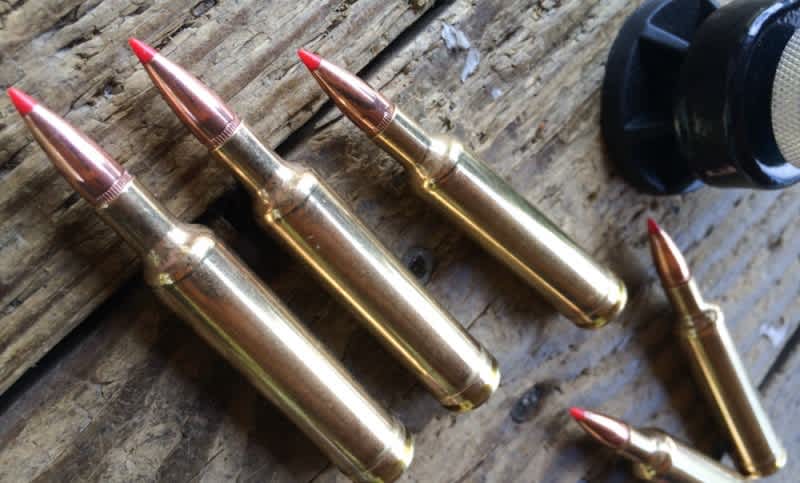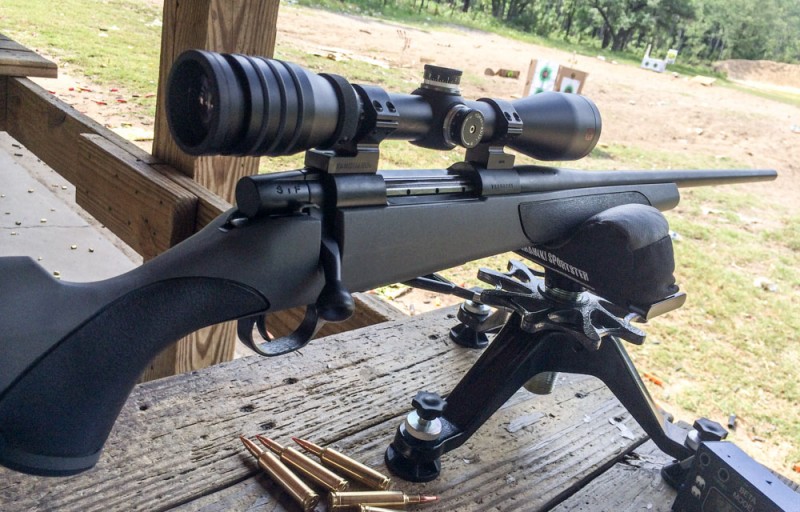I’ve got a thing for unusual calibers. Probably because I’m a reloading addict. I just don’t care that commercial rounds of 300 AAC Blackout cost over a buck each, that .357 SIG pistol ammo is crazy expensive compared to 9x19mm, or that no one stocks 6.8 SPC. I don’t know why, but these oddball cartridges are some of my favorites. When I had a chance to start some serious tinkering with a .257 Weatherby Magnum, how could I resist?
Word is that the .257 Weatherby Magnum was Roy Weatherby’s personal favorite, and that’s saying something. Developed starting back in 1944, it’s a belted cartridge derived from a .375 H&H Magnum case. That’s a lot of case capacity for a .25 caliber bullet. It likes projectiles in the 85- to 120-grain range, with 100-grain bullets being the most common.
All that case capacity is put to good use as the .257 Weatherby is a true speed demon. An 85-grain bullet will move at over 3,800 feet per second, while a 100-grain projectile cooks along at just under 3,600 feet per second. Yes, you have to be considerate to your rifle barrel. Proper cleaning and cooling will extend its life.
If you look at energy, the “standard” .257 load exceeds both the “standard” .308 Winchester and .30-06 loads with over 2,900 foot-pounds of muzzle energy.
If you have to say just one thing about the .257 Weatherby Magnum cartridge, that’s easy: it’s a flat shooter. How flat, you ask? If you fire a 100-grain projectile from a .257 Weatherby Magnum parallel to the ground, it will drop about 46 inches by the time it reaches 500 yards. A .30-06 150-grain projectile will drop about 66 inches over the same distance.

I recently got my hot little hands on a new Weatherby Vanguard 2 Synthetic Package. As the name implies, you get everything you need with this model except ammo. The factory mounts and bore sights a 3-9x42mm Redfield Revenge scope to a Vanguard Series 2 rifle, adds a sling, and packages it all in an injection-molded rifle case. The suggested retail price of the complete package is $999.
The stock is a Monte Carlo style with soft inserts in the pistol grip and fore end areas. These felt great, improved grip, and seemed to help dampen recoil impulse to the hands. The stock has a raised comb and contoured cheek rest area that perfectly positioned my face at scope height.
The barrel is 24 inches long, cold hammer forged, and features a 1 in 10-inch twist rate. Magazine capacity is three, plus a fourth round in the chamber. The magazine features a hinged bottom for easy dumping of unused rounds.
The trigger was crisp and clean. The face is flat with serrations and had no detectable creep. It’s a two-stage design with about 1/8-inch of take-up immediately followed by a clean break. It’s also adjustable down to 2-1/2 pounds of pull weight.
The rifle with scope mounted weighed in at 8-3/4 pounds, although it felt lighter to me. It’s a nice-handling rifle with a great feel.
Accuracy and velocity
I couldn’t bring myself to shoot factory ammo out of such an interesting gun, so I decided to give it a variety diet of carefully hand loaded ammunition. Being a brand new rifle, I broke it in very carefully. I cleaned the barrel and allowed it to cool down between each of the first 10 shots. For the next 20 rounds, I cleaned the bore after every several shots while still monitoring barrel temperature to guard against accuracy loss (and excess wear and tear) through overheating.
In my first outing, I recorded the velocity of a variety of hand loads, and just for the heck of it, fired five-shot groups. As the rifle was still in a break-in period, I didn’t expect perfect accuracy performance (yet) but was curious about how it would shoot right out of the box.
I loaded a half-dozen combinations for initial trial using Hornady 117-grain SST, Nosler 100-grain Ballistic Tip, and Barnes 100-grain TTSX bullets. Powders used were IMR 4351, Hodgdon 4350, and Reloader 25. While I won’t publish load data here (I’m a stickler for getting load data from manufacturer sources only) my load data was sourced from Barnes, Hornady’s guide, and Hodgdon.
I fired five-shot groups at 100 yards and measured the total five-shot spread center to center. I also measured the best three-shot groups within each five just for kicks. Five-shot groups ranged from 1.29 to 2.24 inches, with most groups being in the 1.3-inch range. Three-shot groups ranged from .46 to 1.42 inches.
I have to say that I expected better. But then again, these were the first rounds fired from this rifle and the barrel may have needed some breaking in. I did do the chronograph work first in the earliest stages of barrel break-in to give the first outing groups a fighting chance.

I tested 10 different loads with the three projectiles named. To try a wide range of performance, I developed loads ranging from 2,823 feet per second all the way to 3,410 feet per second, with most clocking in at the 3,100 feet per second range.
Next, I decided to make new loads with longer overall cartridge length. A longer overall length means that the bullet will sit just a bit closer to the rifling and therefore has a shorter “jump” until it engages the grooves and lands. To see how much room I had to work with, I made some dummy rounds (no primer or powder) with each of the three projectiles and barely seated the bullet in the case. I then chambered each in the Vanguard, relying on the rifling to push the projectile into the case just to see how much room there was between projectile and the beginning of the rifling.
There was quite a bit of room to work with. I decided to tinker and make some new loads with the best-performing combinations of bullet, powder, and charge from my initial shooting outing.
Having done a thorough bore cleaning and copper removal with Montana X-treme Copper Killer, I went to the range again with optimized cartridges for this particular rifle. Results improved markedly, with the best three-shot group measuring .35 inches. The second-best group measured .38 inches. The best five-shot group measured .914 inches and used Hornady’s 117-grain SST projectiles with Hodgdon 4350 powder. Out of 20 shots fired for groups, 13 were in some way touching each other.
Felt recoil
According to my buddy Andrew Chamberlain, a serious engineering type who wrote the Cartridge Comparison Guide, the .257 Weatherby Magnum has recoil energy of 15.73 foot-pounds when a 100-grain projectile moving at 3,580 feet per second is fired through an eight-pound rifle. The Weatherby Vanguard with scope attached weighs about 8-3/4 pounds, so the math is pretty close. Felt recoil is less than most .308s using 150-grain projectiles and about the same as the .270 Winchester with a 130-grain bullet, or the 7.5×55 Swiss using a 155-grain projectile.
Subjectively speaking, recoil felt surprisingly mellow with the Weatherby Vanguard. The factory recoil pad is soft and effective. Muzzle blast, on the other hand, is impressive. Shooting at an outdoor range frequented by ARs and bolt-action hunting rifles, the .257 Weatherby still managed to get some attention. It would be an interesting rifle to shoot with a suppressor.
Closing thoughts
Is the .257 Weatherby Magnum the perfect every day deer rifle? Probably not. It’s a great cartridge for game, but ammo is hard to find and expensive. And if it’s to be an everyday rifle, you just might burn out a barrel sooner than you want. But being a substitute for a Marlin .30-30 was never its intent. Having its roots in the wildcat cartridge world, this rifle is all about extreme performance. If you appreciate that, check it out. It’s one of the most fun rifles I’ve shot in quite some time. And it’ll wake you up in the morning.
Tom McHale is the author of the Insanely Practical Guides book series that guides new and experienced shooters alike in a fun, approachable, and practical way. His books are available in print and eBook format on Amazon.













